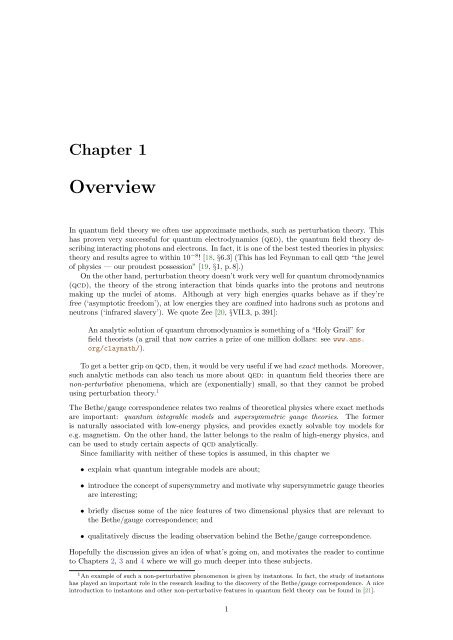The Bethe/Gauge Correspondence
The Bethe/Gauge Correspondence
The Bethe/Gauge Correspondence
You also want an ePaper? Increase the reach of your titles
YUMPU automatically turns print PDFs into web optimized ePapers that Google loves.
Chapter 1OverviewIn quantum field theory we often use approximate methods, such as perturbation theory. Thishas proven very successful for quantum electrodynamics (qed), the quantum field theory describinginteracting photons and electrons. In fact, it is one of the best tested theories in physics:theory and results agree to within 10 −8 ! [18, §6.3] (This has led Feynman to call qed “the jewelof physics — our proudest possession” [19, §1, p. 8].)On the other hand, perturbation theory doesn’t work very well for quantum chromodynamics(qcd), the theory of the strong interaction that binds quarks into the protons and neutronsmaking up the nuclei of atoms. Although at very high energies quarks behave as if they’refree (‘asymptotic freedom’), at low energies they are confined into hadrons such as protons andneutrons (‘infrared slavery’). We quote Zee [20, §VII.3, p. 391]:An analytic solution of quantum chromodynamics is something of a “Holy Grail” forfield theorists (a grail that now carries a prize of one million dollars: see www.ams.org/claymath/).To get a better grip on qcd, then, it would be very useful if we had exact methods. Moreover,such analytic methods can also teach us more about qed: in quantum field theories there arenon-perturbative phenomena, which are (exponentially) small, so that they cannot be probedusing perturbation theory. 1<strong>The</strong> <strong>Bethe</strong>/gauge correspondence relates two realms of theoretical physics where exact methodsare important: quantum integrable models and supersymmetric gauge theories. <strong>The</strong> formeris naturally associated with low-energy physics, and provides exactly solvable toy models fore.g. magnetism. On the other hand, the latter belongs to the realm of high-energy physics, andcan be used to study certain aspects of qcd analytically.Since familiarity with neither of these topics is assumed, in this chapter we• explain what quantum integrable models are about;• introduce the concept of supersymmetry and motivate why supersymmetric gauge theoriesare interesting;• briefly discuss some of the nice features of two dimensional physics that are relevant tothe <strong>Bethe</strong>/gauge correspondence; and• qualitatively discuss the leading observation behind the <strong>Bethe</strong>/gauge correspondence.Hopefully the discussion gives an idea of what’s going on, and motivates the reader to continueto Chapters 2, 3 and 4 where we will go much deeper into these subjects.1 An example of such a non-perturbative phenomenon is given by instantons. In fact, the study of instantonshas played an important role in the research leading to the discovery of the <strong>Bethe</strong>/gauge correspondence. A niceintroduction to instantons and other non-perturbative features in quantum field theory can be found in [21].1
















